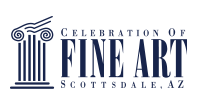What does your hometown have to do with what kind of artist you become? For Jenny Foster, a small Arizona town along the Colorado River surrounded by petroglyphs and pottery shards left by the American Indians was exactly what fed her early exploration into art and continues to influence her style today.
“When I was seven years old I had an easel so naturally, I went into painting mode,” Jenny says. “We had a wonderful craft store in town. That was the first time I ever painted and I’ve been pretty much completely obsessed ever since.”
Decades later, Jenny’s mixed media paintings on canvas continue to incorporate the bold, contemporary beauty from the relics of her past. She eschews a realistic style in favor of capturing the essence of her subject matter, which typically involves joyful, whimsical subjects with stylized patterns and shapes.
“I paint a lot of animals because of my love for animals,” Jenny says. “I love to get a certain expression from the animals through their eyes in a simple way. But it doesn’t have to be animals. This year I painted kids and flowers and different things, but if it’s not happy it doesn’t make it on my wall.”
So how does Jenny find inspiration for these delightful creatures she paints? Sometimes in the oddest places.
“The other morning I woke up laying in my bed staring at the ceiling and the plaster on the ceiling was a composition,” Jenny says. “Then that same day I went outside to get my mail and saw this crack in the asphalt that looked like a chicken leg. It became a chicken leg in a painting I was working on that I’d struggled to get right. And there it was –– perfect!”
Jenny’s art –– bursting with bright, cheerful characters –– is what has brought visitors back to her studio for the 17 years she’s been a part of the Celebration of Fine Art. This face-to-face interaction with art lovers of all ages has changed Jenny’s life and motivates her year round.
“This show keeps me busy all year,” Jenny says. “It’s a working show and we’re here for 10 weeks. We get to meet people that come in and we hear good things about our art, we hear bad things about our art. It doesn’t matter, because we get the interaction with people who love art.”
Sometimes that feedback comes directly from the people working in surrounding studios.
“Some of the artists here have become my best friends,” Jenny says. “We all help each other on different creative challenges that we might have. A sculptor helped me the other day figure out the base of a sculpture I was working on. We’re all very supportive of each other. It’s a great show.”
See more of Jenny’s story here:

